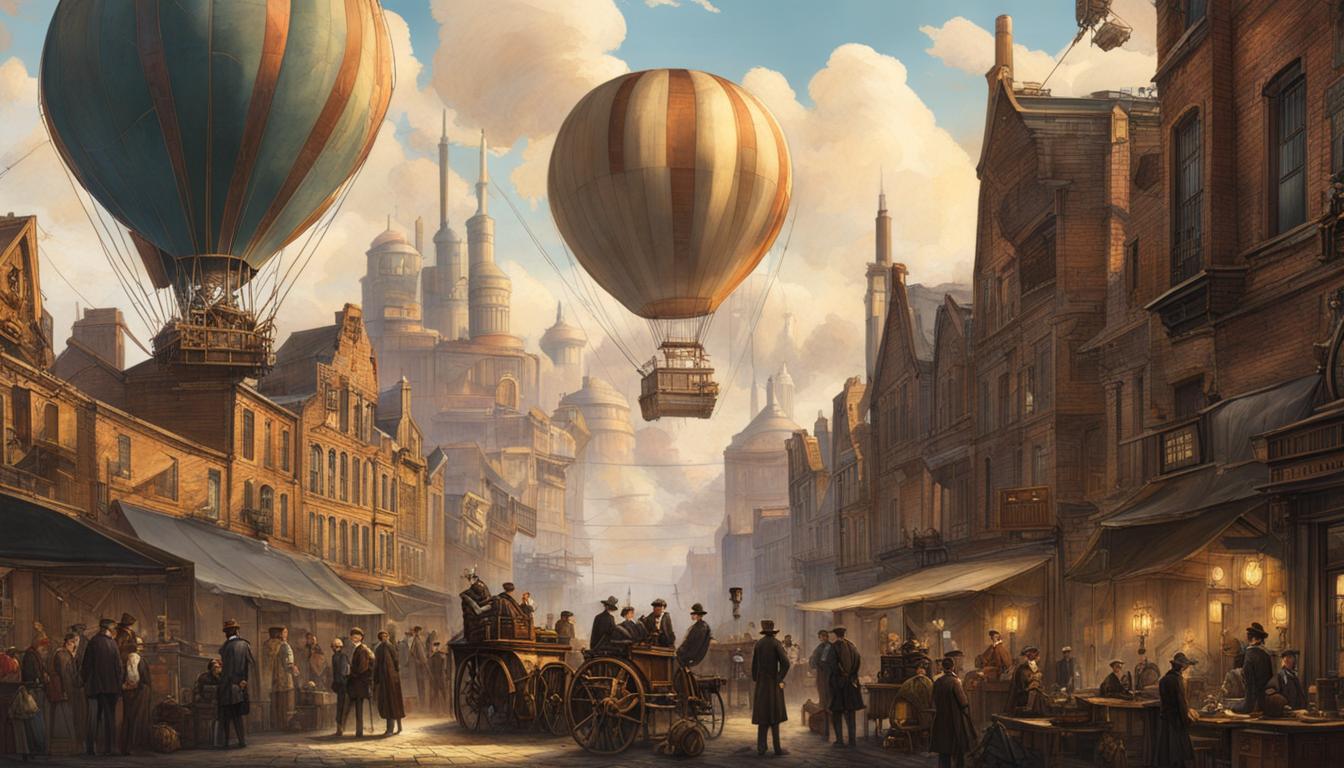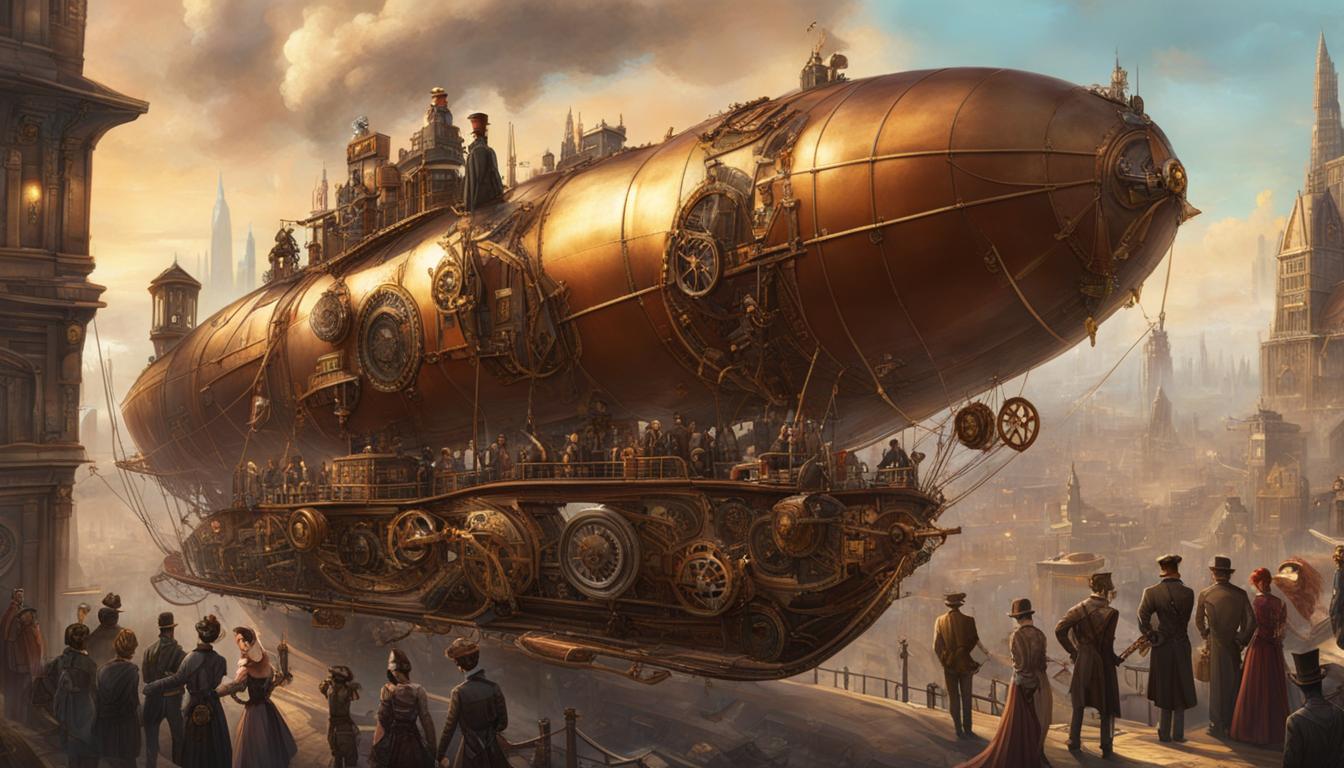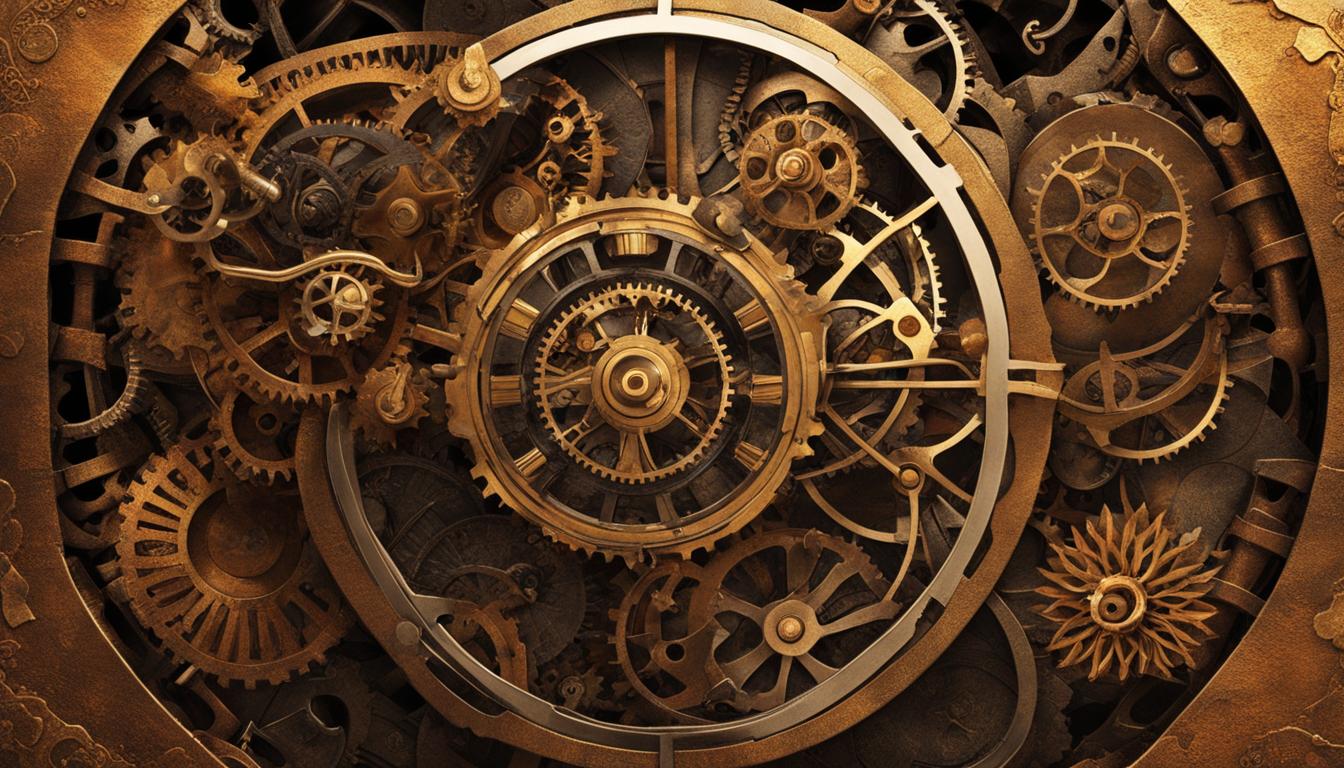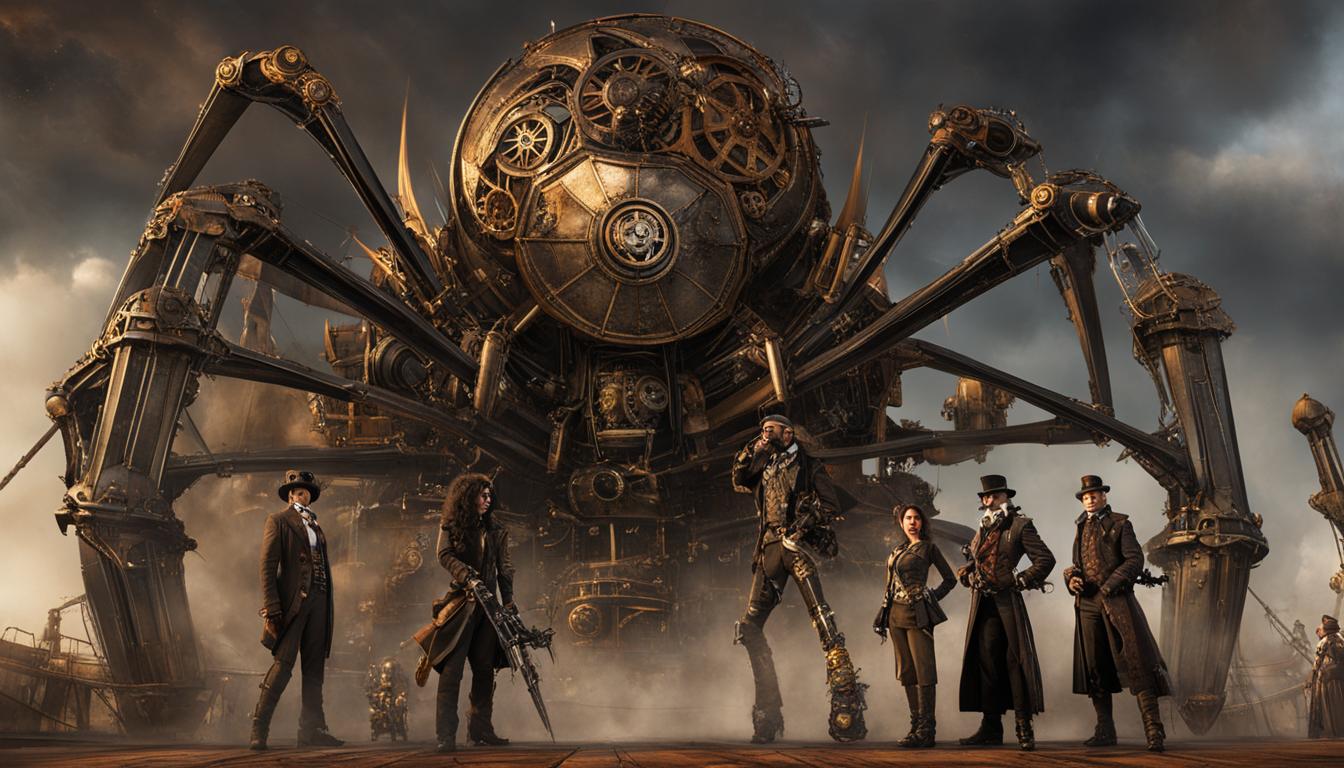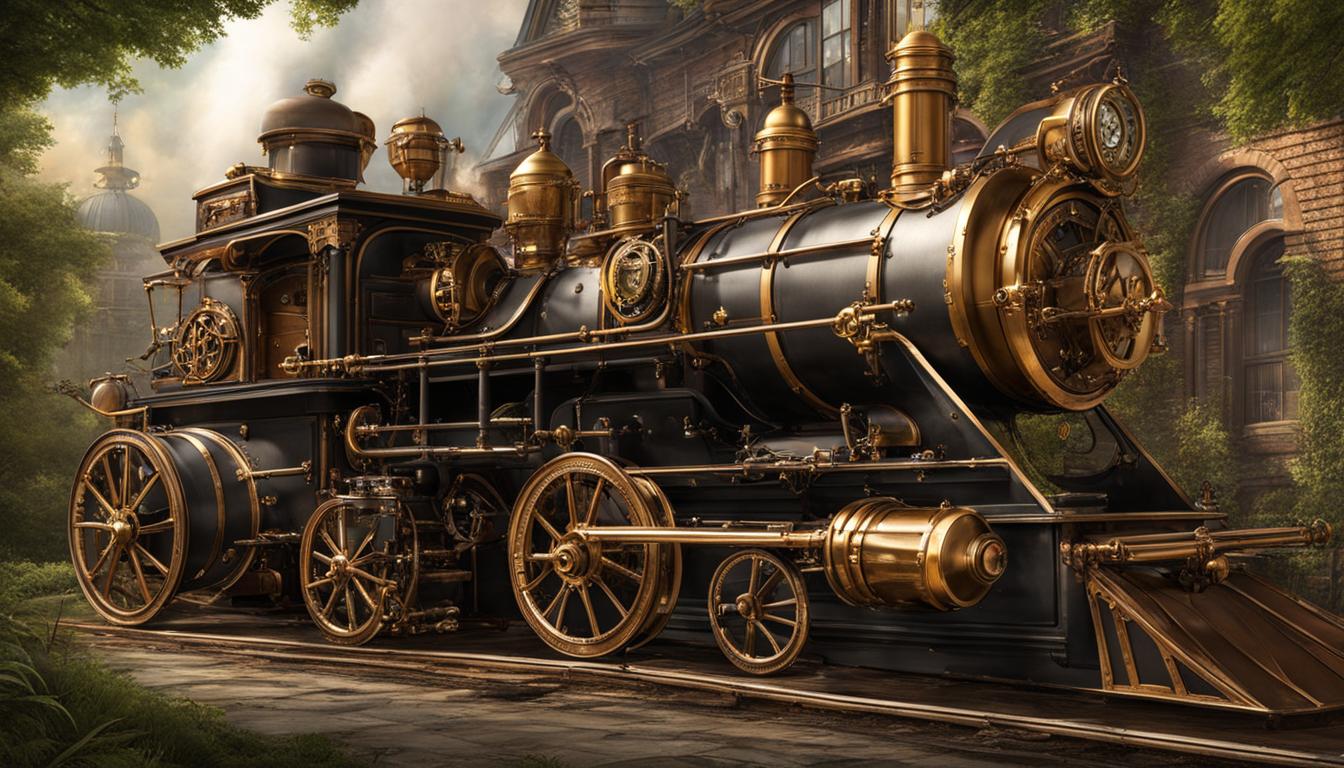Steampunk, the captivating subgenre of science fiction, draws inspiration from real historical events to create compelling narratives that blend history and fantasy. These stories reimagine and reinterpret the past, offering readers alternative versions of reality where steam power remains at the forefront of technological advancement. Through this unique fusion of fact and fiction, steampunk breathes new life into bygone eras, captivating audiences with its immersive blend of history and imagination.
Key Takeaways:
- Steampunk narratives are influenced by real historical events.
- Steampunk offers alternative versions of reality through the use of retrofuturistic technology.
- The fusion of history and imagination adds depth and richness to steampunk stories.
- Steampunk captivates readers with its immersive blend of fact and fiction.
- Real-world events inspire the unique and captivating world of steampunk.
The Evolution of Steampunk as a Genre
Steampunk has a lengthy history that has evolved over time. It first emerged as a subgenre of science fiction in the 1970s, inspired by the works of Victorian-age writers like Jules Verne and H.G. Wells. However, it wasn’t until the early 2000s that steampunk experienced a resurgence and became more than just a literary genre. This period marked the emergence of the countercultural community, which embraced the do-it-yourself ethos and transformed steampunk into a material culture.
The first wave of American steampunk played a key role in popularizing the genre. Authors like Tim Powers, James P. Blaylock, and K.W. Jeter introduced readers to the fantastical world of steam-powered machines and Victorian aesthetics. Their pioneering works laid the foundation for the second wave of steampunk, which saw the genre’s expansion beyond literature.
During this second wave, steampunk evolved into a vibrant subculture and artistic movement. Steampunk enthusiasts brought the genre to life through cosplay, fashion, art, and even functional inventions. The community’s passion for Victorian-inspired fashion, modified brass gadgets, and retrofuturistic designs became the visual hallmarks of steampunk, captivating audiences with its unique aesthetic.
Steampunk as a Material Culture
Steampunk has transcended its origins as a literary genre and has become a material culture, where enthusiasts actively engage in creating and experiencing the steampunk aesthetic through fashion, art, and design.
| The Evolution of Steampunk | Key Takeaways |
|---|---|
| First Wave (1970s) | Authors like Tim Powers, James P. Blaylock, and K.W. Jeter introduced steampunk as a subgenre of science fiction, drawing inspiration from Victorian-age writers. |
| Second Wave (Early 2000s) | The countercultural community embraced steampunk, expanding it beyond literature and transforming it into a material culture through cosplay, fashion, art, and functional inventions. |
Today, steampunk continues to evolve, captivating audiences with its fusion of history and fantasy. Its unique blend of Victorian aesthetics, alternative histories, and social commentary make it a genre that appeals to both readers and creators alike. Steampunk’s longevity and enduring popularity are a testament to its ability to transport us to a different time and place while also addressing contemporary issues and pushing the boundaries of imagination.
Steampunk’s Unique Aesthetic and Style
The visual aesthetic of steampunk is a captivating blend of Victorian-era fashion and retrofuturistic inventions. This distinctive visual iconography sets steampunk apart from other genres and is instantly recognizable. Gears, goggles, corsets, and modified brass gadgets are among the visual hallmarks that define the steampunk style. Whether it’s in literature, fashion, or art, the steampunk aesthetic transports us to a world where the past meets the future in a mesmerizing fusion of elegance and innovation.
Victorian-inspired fashion plays a significant role in the steampunk subculture. The elaborate dresses, waistcoats, top hats, and other period clothing are reimagined with a steampunk twist, incorporating gears, clockwork motifs, and industrial elements. Steampunk enthusiasts embrace this fashion as a form of self-expression, allowing them to embody the spirit of adventure, curiosity, and ingenuity that permeates the genre.
Steampunk also celebrates retrofuturistic inventions, where the Victorian era’s advanced steam power and mechanical prowess coexist with futuristic technologies that never came to be. Airships, steam-powered locomotives, and elaborate contraptions powered by gears and cogs are common elements in steampunk narratives and artwork. These inventions not only add to the visual appeal of the genre but also highlight the ingenuity and resourcefulness of steampunk characters who navigate a world on the brink of scientific advancements.
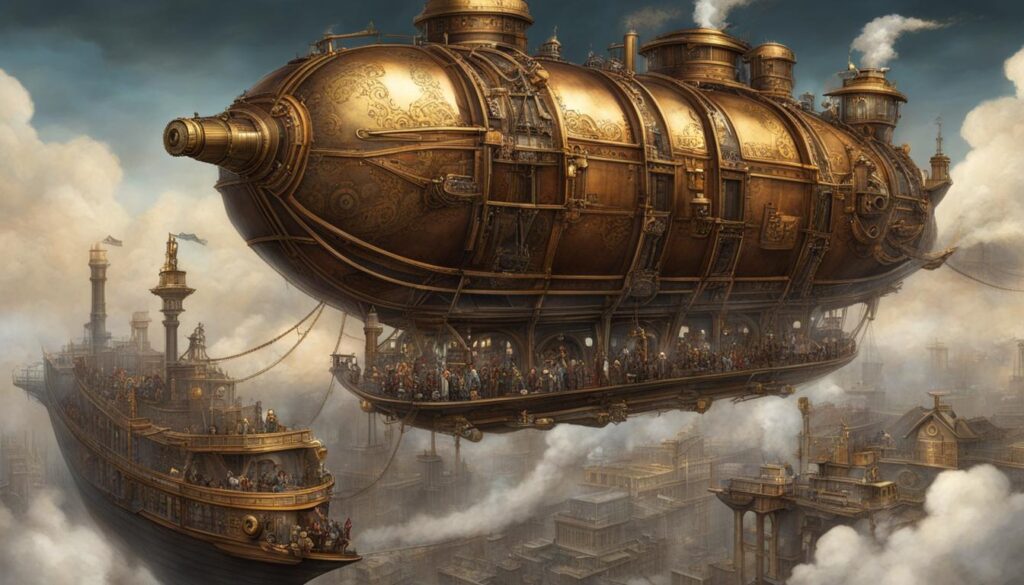
The Artistry of Steampunk
Steampunk fashion and design are rooted in the Victorian era but incorporate elements of fantasy and imagination, resulting in a visually striking and distinct aesthetic. The genre’s visual appeal goes beyond mere decoration; it showcases the artistry and craftsmanship of steampunk enthusiasts. DIY culture is a cornerstone of the steampunk community, where individuals create their own unique steampunk-inspired creations, from elaborate costumes to intricate handmade accessories. This hands-on approach further enhances the immersive experience of the steampunk world and fosters a sense of creativity and individuality among its followers.
The steampunk aesthetic is like stepping into a time machine that combines the elegance of the past with the imaginative wonders of the future.
Diverse Expressions of Steampunk Style
While steampunk is often associated with Victorian England, its visual aesthetic transcends borders and represents a fusion of cultures and time periods. Steampunk enthusiasts worldwide have infused their own cultural influences into the genre, resulting in unique and diverse expressions of steampunk style. From steampunk-inspired kimono designs in Japan to Native American-inspired steampunk regalia, the genre’s visual iconography has evolved into a multicultural tapestry that celebrates individuality and inclusivity.
- Steampunk fashion is not limited to traditional gender norms, with both men and women donning elaborate outfits that defy expectations.
- Accessories play a crucial role in steampunk style, with goggles, pocket watches, and compasses serving as symbols of adventure, exploration, and scientific curiosity.
- The steampunk aesthetic extends beyond clothing and accessories to encompass home decor, jewelry, and even functional gadgets inspired by the fusion of Victorian elegance and futuristic technology.
The Enduring Allure of Steampunk
The unique aesthetic and style of steampunk have captivated audiences for decades, and its popularity shows no signs of waning. The genre continues to inspire artists, designers, and writers who find endless possibilities in the juxtaposition of the past and the future, the familiar and the fantastical. Whether through fashion, literature, or visual art, steampunk remains a captivating and imaginative subculture that invites us to explore new worlds and reimagine our own.
Steampunk’s Alternate Histories and Social Commentary
Steampunk literature is not just about fantastical inventions and Victorian aesthetics; it also serves as a platform for social commentary and explores alternative versions of history. By blending fiction with real events, steampunk authors challenge traditional narratives and offer thought-provoking insight into contemporary issues.
In steampunk, history is reimagined, providing a unique lens through which to examine societal norms and power dynamics. It allows authors to question and critique the established order, offering readers a fresh perspective on the world. The blending of history and fiction in steampunk narratives creates an engaging and immersive experience, where readers can ponder the possibilities of what could have been.
“Steampunk is not just about escapism; it’s about using the past to reflect on the present and imagine a better future.”
Through alternative histories, steampunk tackles themes such as colonialism, industrialization, and social inequality. It sparks conversations about the consequences and implications of past events, drawing parallels to contemporary issues. By examining the choices made in the past, steampunk encourages readers to consider the choices they make today and their potential impact on the future.
Table: Blending Fiction and History in Steampunk
| Aspect | Explanation |
|---|---|
| Alternative Histories | Steampunk authors create alternative versions of history, exploring what could have been and offering social commentary on the present. |
| Social Critique | Steampunk narratives challenge societal norms and power dynamics, providing a platform for authors to critique the established order. |
| Reflection and Imagination | Blending fiction and history in steampunk allows for an immersive reading experience that prompts reflection on the past and sparks the imagination for the future. |
Steampunk’s ability to blend history and fiction is what sets it apart from other genres. It offers a unique space for authors and readers to explore and question the world we live in, leaving room for imagination and inspiration. Whether it’s the reimagining of historical events or the examination of social issues, steampunk continues to push the boundaries of storytelling, making it a fascinating and thought-provoking genre.
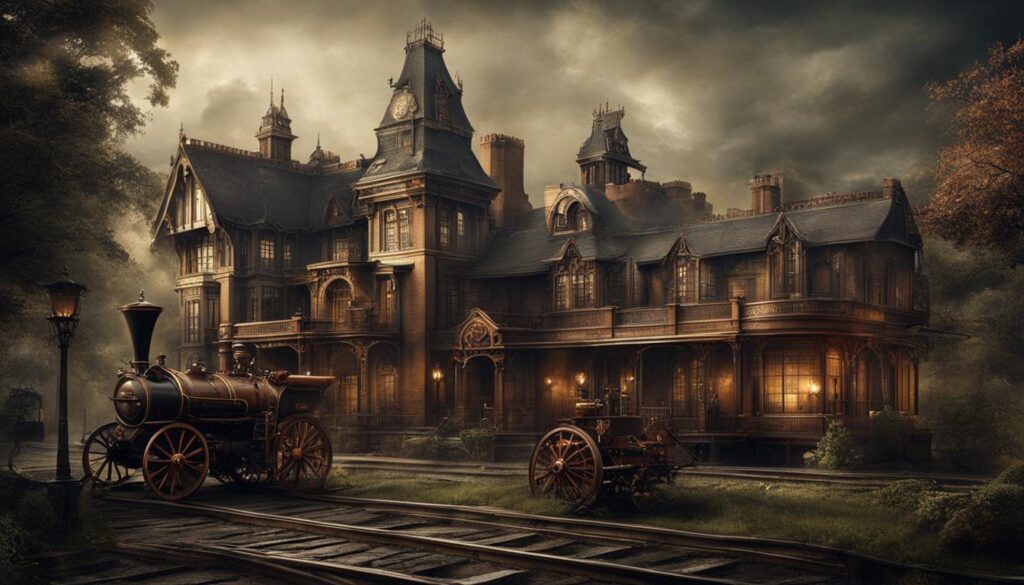
Steampunk’s Political and Ideological Significance
Steampunk goes beyond its literary and aesthetic elements; it holds a significant political and ideological meaning. With its progressive political edge, steampunk challenges dominant narratives and offers a platform for marginalized voices. Emphasizing multiculturalism, postcolonialism, and anticonsumerism, steampunk envisions alternative futures and pasts to critique the present.
“Steampunk allows us to reimagine history and explore social and political issues through the lens of an alternative past. It offers a way to question power structures and imagine a more inclusive and equitable society.” – Steampunk enthusiast and author
Incorporating multicultural and postcolonial dimensions, steampunk narratives provide a space for diverse perspectives and highlight the contributions of marginalized communities. By blending history and fiction, steampunk challenges traditional ideologies and fosters a vision for a better future. It serves as both an ideological critique and a call for social change.
The Multicultural and Postcolonial Dimensions of Steampunk
The multicultural and postcolonial dimensions of steampunk are evident in its portrayal of diverse characters and alternative histories. Steampunk stories often feature protagonists from various ethnic backgrounds and highlight their contributions to society. By including these perspectives, steampunk challenges the dominant historical narratives that often disregard or marginalize non-western cultures.
Additionally, steampunk reimagines the colonial era by depicting alternative outcomes and empowering previously oppressed groups. It offers a platform for exploring the consequences of imperialism and the potential for resistance and liberation. Through its narratives, steampunk encourages critical reflection on the past and present, fostering conversations about social justice and equity.
Steampunk’s political and ideological significance cannot be overlooked. From its progressive political edge to its focus on multicultural and postcolonial dimensions, steampunk serves as a form of resistance and an imaginative vision for a more inclusive and equitable future.
| Steampunk’s Political and Ideological Significance | Keywords |
|---|---|
| Progressive political edge | steampunk’s progressive political edge |
| Multicultural and postcolonial dimensions | multicultural and postcolonial dimensions of steampunk |
| Ideological critique and social change | steampunk as ideological critique |
Conclusion
Steampunk’s appeal lies in its ability to seamlessly blend history and fantasy, transporting readers to a captivating world where the influence of real events intertwines with imaginative storytelling. By reimagining and reinterpreting historical events, steampunk authors create alternative versions of the past that are both familiar and fantastical. This fusion of fact and fiction adds depth and authenticity to the narratives, capturing the imagination of readers and keeping them hooked until the very last page.
It is this unique blend of history and fantasy that contributes to the enduring popularity of steampunk. Steampunk’s ability to transport readers to a different time and place while addressing contemporary issues makes it a genre that transcends boundaries and resonates with audiences worldwide. Whether through its exploration of alternate histories, social commentary, or political ideologies, steampunk continues to evolve and push the boundaries of storytelling.
So, whether you are fascinated by the intricate machinery and retrofuturistic inventions of steampunk or intrigued by its ability to offer social commentary and critique societal norms, there is no denying the lasting impact of this captivating genre. Steampunk’s enduring appeal lies in its ability to transport us to a world where history and fantasy converge, inviting us to explore the past, envision alternative futures, and challenge the status quo.
FAQ
How are real historical events incorporated into steampunk stories?
Steampunk stories reimagine and reinterpret real historical events, creating alternative versions of the past where steam power remains in mainstream use. This fusion of fact and fiction adds depth and richness to steampunk narratives, captivating readers with its unique blend of history and imagination.
When did steampunk experience a resurgence?
Steampunk experienced a resurgence in the early 2000s, becoming more than just a literary genre. This second wave of steampunk saw the rise of a countercultural community that embraced the DIY ethos and transformed steampunk into a material culture.
What is the visual aesthetic of steampunk?
Steampunk features a blend of Victorian-era fashion and retrofuturistic inventions. Gears, goggles, corsets, and modified brass gadgets are among the visual hallmarks of steampunk. This unique style not only adds to the immersive reading experience but also serves as a form of self-expression and a way for steampunk enthusiasts to showcase their creativity.
How does steampunk literature explore alternative histories?
Steampunk literature often reimagines historical events and offers social commentary on the present. By blending fact and fiction, steampunk allows authors to comment on contemporary issues and challenge traditional ideas. This blending of history and fiction gives steampunk stories a unique depth and relevance, making them not just entertaining but also thought-provoking.
What political and ideological significance does steampunk carry?
Many steampunk works have a progressive political edge, emphasizing multiculturalism, postcolonialism, and anticonsumerism. Steampunks reimagine the past and use it as a lens to examine and critique the present. It is a form of resistance and protest, embodying a vision for a better future and a call for social change.

